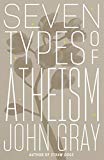Books Reviewed
John Gray is a prominent English philosopher whose major books include Straw Dogs (2002), Black Mass (2007), and The Silence of Animals (2013). Gray is a provocative thinker who has written on a wide range of thinkers and subjects. He has written on Friedrich Hayek, but he is not exactly a libertarian. He attacks modern atheism, but he is clearly not a conservative either. He is a serious thinker who clearly enjoys provoking the academic establishment by unmasking their hidden progressive pieties. His latest is Seven Types of Atheism.
The title is a nod to William Empson’s 1930 book, Seven Types of Ambiguity. Like poetry and language (the focus of Empson’s book), atheism has many different forms. Gray’s purpose is not to persuade the reader to believe or not to believe in God, but to explore modern atheism and the problems with it. In an age when prominent atheists, such as Richard Dawkins, Daniel Dennett, Sam Harris, and the late Christopher Hitchens—affectionately referred to as the “Four Horsemen of New Atheism”—are celebrated for their sophisticated disdain for religion and commitment to progress, Gray’s book arrives on the scene like an uninvited guest to a premature celebration of the death of God. Gray is a unique thinker with little patience for false and shallow forms of atheism. For this reason, among many others, he should be taken seriously by thoughtful atheists and believers alike.
* * *
Scratch a contemporary atheist or a modern secular humanist, he argues, and you’ll find a confused rebel who is essentially religious. Modern atheism is religion in a new garb. These atheists “think they have left religion behind, when all they have done is renew it in shapes they fail to recognize.” They substitute faith in humanity and progress for belief in God, and are driven by the desire to serve nature, humanity, history, or progress. This is not to suggest that Gray is a critic of atheism and a defender of religion. An atheist himself, he is a critic of both. He believes science and religion are two separate human activities, though not as distinct as many presume, and that modern atheism is prone to utopianism and self-deification.
To take one extreme example: the Marquis de Sade’s originality, according to Gray, lies not in Sade’s atheism but in his nightmarish vision of nature as a malevolent goddess with an insatiable appetite for destruction. “Nature has elaborated no statuses, instituted no code; her single law is writ deep in every man’s heart: it is to satisfy himself, deny his passions nothing, and this regardless of the cost to others,” wrote Sade. Nature sanctions egoism and inspires in humans a lust for motiveless destruction and cruelty.
For Sade, every impulse of nature and everything that humans do and desire to do is natural. In the Dialogue between a Priest and a Dying Man, Sade rails against God and accuses religion of corrupting natural humanity. Yet, as Gray points out, “if everything human beings do is natural, how can religion be singled out as being contrary to Nature?” Moreover, “[i]f everything humans do is ordained by Nature, they are following Nature when they obey morality and convention.”
According to Gray, Sade’s ruling passion is not atheism but hatred of God. Sade is “the greatest modern prophet of misotheism—the current of thought that hates God as the enemy of humanity.” The hatred of God within Sade’s soul is in conflict with real disbelief in God. Simone de Beauvoir got it wrong, then, when in her essay “Must We Burn Sade?” she declared that “Sade’s nature was thoroughly irreligious.” To the contrary, says Gray, Sade’s hatred of religion and his desire to convert his readers away from God shows he never abandoned religion, but exchanged one deity for another: “Rejecting the Christian God as evil, he turned to Nature; but evil returned in the form of the dark goddess he had invented. His solution was to rebel against Nature even as he obeyed the destructive impulses it had implanted in him.” For atheists who truly believe that the cosmos is godless and that humanity lacks cosmic significance, there is no problem of evil, nor is there any sense in railing against (a nonexistent) God.
* * *
Not all atheists express their repressed religious instincts through cruelty. We learn from his Autobiography that the gentle John Stuart Mill never had to overcome belief in Christianity because he was never reared in any traditional faith to begin with. He was an atheist in the traditional sense of the term. Nevertheless, Gray finds Christian elements in Mill’s belief in humanity and its progress over time. “[B]elief in improvement,” writes Gray, “is the unthinking faith of people who think they have no religion.”
In order to discredit Mill’s faith in progress and humanity as just another example of repressed religion, Gray tries to show how humanity’s supposed progression is in conflict with Mill’s empiricist philosophy. According to Mill, everything we recognize in the world—physical objects, human beings—is constructed from sensory impressions and born out of experience. His conception of humanity, however, was not and could not have been based on observation or experience. It is rooted in his moral beliefs, which Gray traces to Christianity, a religion Mill falsely assumed he stood outside of. It is not clear why Gray thinks that faith in progress is inconsistent with atheism, other than to point out in a number of places that humans are generally irrational and cruel.
This is not to say, however, that Gray denies progress in the sciences. His point is that the dramatic and obvious progress in science has misled many into believing that we can progress in all areas of our lives, when there’s not a shred of evidence that human nature has improved. “Knowledge increases at an accelerating rate, but human beings are no more reasonable than they have ever been.” From the French Revolution to the rise of Nazism and fascism to the increasing rise of Islamist violence around the world, “instead of being left behind, old evils return under new names.” All of this suggests, for Gray, that “the cumulative increase of knowledge in science has no parallel in ethics or politics, philosophy or the arts.” Secular thinkers who believe humans have morally improved are deluded and flatter themselves into assuming that they themselves embody the progress of world history.
The idea of history with an ultimate purpose is fundamentally Christian, Gray argues. Secular humanism’s faith in progress is a spin-off from the mystical speculations of medieval theologians. G.W.F. Hegel’s view of history as a progressive process of human self-realization in which the disparate fragments of history reassemble through the dialectical working of the world spirit is just a variant on the same old theme. History, according to Gray, is going nowhere.
* * *
Gray insists that not all atheism is a flight from a godless universe and at odds with a world bereft of significance. There have been some atheists “who stepped out of monotheism altogether and in doing so found freedom and fulfillment. Not looking for cosmic meaning, they were content with the world as they found it.” Epicurean atheists in antiquity were more dispassionate than their modern counterparts. They promoted an ethics in which the simple but noble pleasures of peace of mind are the authentic ends of human existence. Resisting the beguiling illusion of human progress, Epicurean thinkers such as Lucretius insulated themselves from the sorrows and madness of their fellows. Perched calmly above the noise and misery of those drowning in their disappointed hopes, Epicureans were content in the tranquil sanctuary of their secluded gardens.
An example of ancient atheism in the modern world is George Santayana, whom Gray clearly admires. Santayana was an atheist who rejected any idea that civilization was improving, and found happiness and tranquility in detaching himself from the world. He made a conscious decision to renounce love and academic prestige for the sake of peace of mind, fearing the loss of independence and tranquility that is the price of love and vanity. For Santayana, unlike modern atheists and secular humanists, the realm of perfection and progress lies neither in politics, nor humanity, nor history, but in technology and the mechanical arts. Although he recognized the role religion plays in the lives of many, Santayana rejected any claim to prescribe a universal way of life for all. Respecting religion in general, writes Gray,
he deplored monotheism when it was militant and evangelical. The cardinal error of Christianity came from Platonism, which (for Christians who adopted it) conceived the Good to be a power in the world. Having identified itself with this power, the Church inevitably became repressive of human variety.
Santayana was a materialist who found freedom in the godless flux of matter. It is unclear how he was able to grasp the godlessness of the cosmos and yet ground in materialism the life of the mind he enjoyed, but he at least believed that he found peace of mind and happiness in his pursuit of equanimity.
Arthur Schopenhauer is, like Santayana, an atheist whom Gray respects. Believing human beings to be incurably irrational, Schopenhauer argued that all human troubles come from the will’s insatiable and irrational cravings. The universe, like humans, is inscrutable. He rejected Christianity and dismissed Hegel’s view of history as Christian theodicy masquerading as philosophy. Hegel’s philosophy paved the way for modernity to replace God with humankind and created the illusion that history contained some sort of meaning. For Schopenhauer, history has no meaning. No act of will can bring sense to the senseless drift of human events. Only by renouncing the world and denouncing it as an illusion can one shed the false hope in history and mankind. Even the human mind is “itself nothing, and in looking beyond itself it is seeking to pierce the veil of maya—universal illusion—and come nearer to reality.” Schopenhauer’s rejection of reason and meaning in the world eventually led him to mysticism.
* * *
The point of Gray’s reflections is to show that monotheism’s God did not die, but has only reappeared in the different guises of surrogate deities. “A free-thinking atheism,” he maintains, “would begin by questioning the prevailing faith in humanity. But there is little prospect of contemporary atheists giving up their reverence for a phantasm of humanity.” Science will never replace religion because without the illusion of progress and reverence for humanity, human beings cannot make sense of their lives and will fall into panic and despair. So how ought we to live in the godless world described by John Gray? Despair? Not necessarily. Gray says he’s an atheist who maintains a reverence for a universe he claims is godless and mysterious. Yet his reverence and awe somehow escape the charges he levels against the modern atheists. Nevertheless, he prefers atheism without the belief in progress, as opposed to the atheism of secular humanism, because the former is ultimately more humane and free from deluded visions of improvement. One cannot but wonder whether Gray himself escapes a hidden belief in Christianity.
Although he writes in a clear, engaging manner, and his book is interesting and informative, Gray rarely applies the same scrutiny to those whom he admires, like Santayana. Why is Santayana, who has all the otherworldliness of a saint, for example, not perceived as a repressed religious ascetic, while others, such as Mill and Friedrich Nietzsche, are reduced to deluded faux atheists? Why is Schopenhauer’s “managed hedonism” “refreshing,” while his turn to Indian philosophy as a means to gaining salvation by destroying the illusion of selfhood not viewed as a version of Christian salvation in Indian garb? Perhaps—and this is just a hunch—the answer lies in Gray’s disdain for the self-deification of atheists and humanists who harm humanity with their revolutions and don’t pause from the noise of their deluded hopes to pay their proper respects to a mysterious universe.







